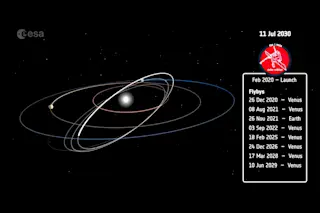The European Space Agency's Solar Orbiter, launched on February 10, is going where no space probe has gone before: over the north and south poles of the Sun. Six decades into the space age, robots have roamed the deserts of Mars, swooped past the rings of Saturn, and hopped across rubble-strewn asteroids. And yet, strange as it sounds, Solar Orbiter is the first mission that will show us what the Sun looks like from above and below.
Our blinkered view of the Sun is rooted in a much broader limitation in the way we view the solar system. All of the planets orbit in roughly the same plane, circling almost directly above the equator of the Sun. Since Earth is right there in the mix with the other planets, we are looking out at them from within that plane, and we therefore see them all sideways relative to the Sun. ...














